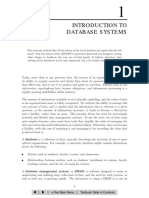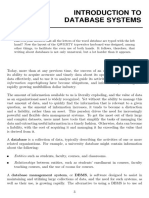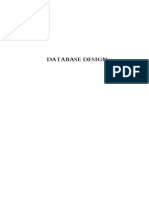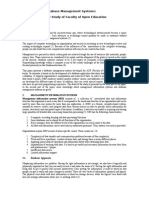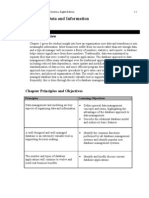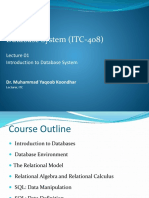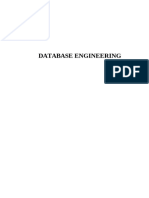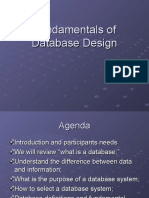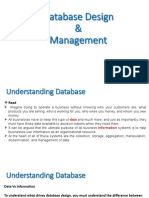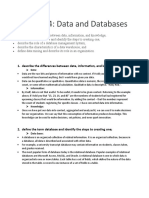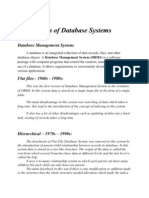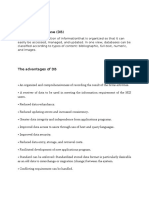Chapter 5: Database Processing 1
Chapter 5: Database Processing 1
Uploaded by
kperry369Copyright:
Available Formats
Chapter 5: Database Processing 1
Chapter 5: Database Processing 1
Uploaded by
kperry369Original Description:
Original Title
Copyright
Available Formats
Share this document
Did you find this document useful?
Is this content inappropriate?
Copyright:
Available Formats
Chapter 5: Database Processing 1
Chapter 5: Database Processing 1
Uploaded by
kperry369Copyright:
Available Formats
Chapter 5: Database Processing
Chapter 5: Database Processing
Kevin Perry
Southern New Hampshire University
Module 7 Assignment V
2
Table of Contents
Introduction
Q1: What Is the purpose of a database?
Q2: What is a database?
Q3: What is a database management system (DBMS)?
Q4: How do database applications make databases more useful?
Q5: How are data models used for database development?
Q6: How is a data model transformed into a database design?
Q7: What is the users' role in the development of databases?
Q8: 2024
Conclusion
Works Cited
Chapter 5: Database Processing
3
Introduction
Databases are used by almost all business today. They allow organizations to store, keep track,
organize, and display their data. This data can be anything from simple customer contact information
to large tables of suppliers, their rating, their preferences, their past orders and potential future ones.
Databases have become a key component of everyday business and tend to form the back bone of most
organizations Information Technology infrastructure. Organizations use applications like Microsoft
Access and database management systems (DBMS).
Q1: What Is the purpose of a database?
The purpose of a database is to keep track of things(Kroenke, 2014). Professionals can use
lists and spreadsheets to do this but once the structure becomes too complex, a database is the only way
to go. Lists of data involving a single theme can be stored in a spreadsheet; lists that involve data with
multiple themes require a database(Kroenke, 2014). Within organizations, databases keep track of all
the data that the organization finds important, is needed, or wants to keep safe.
Q2: What is a database?
A database is a self-describing collection of integrated records(Kroenke, 2014). This means,
bytes; characters of data; are grouped into columns or fields. These are then grouped into rows or
records. Lastly, the rows or records are grouped into a table or a file. While it can be said that a
database is therefore just a group of tables or files, this doesn't completely describe a database. More
specifically, a database is a collection of tables plus relationships among the rows in those tables, plus
special data (metadata) that describes the structure of the database(Kroenke, 2014). Keys are used to
identify a unique row in a table so every table must have a key. Sometimes, a key can consist of
multiple columns. Metadata is data used to describe other data( Ramakrishnan, 2003). It is used
make a database self-describing, like a card catalog within a library. It makes databases more useful by
keeping users from guessing, remembering, or recording what is in them.
Module 7 Assignment V
Q3: What is a database management system (DBMS)?
A database management system, or DBMS, is software designed to assist in maintaining and
utilizing large collections of data( Ramakrishnan, 2003). Developers use DBMS to dreate tables,
relationships, and other structures in the database(Kroenke, 2014). By altering the metadata, the
developer changes the database. DBMS also process the database. They provide four operations, to
read, insert, modify, or delete data. Lastly, DBMS also provide administrative tools for databases.
These include security features, back up functions, way to improve performance and others.
Q4: How do database applications make databases more useful?
The data in database tables can be made more useful, or more available for the conception of
information, when it is placed into forms or other formats (Kroenke, 2014). This is done through
database applications. A database application is a collection of forms, reports, queries, and application
programs that serves as an intermediary between users and database data(Kroenke, 2014). They make
database tables more informative ad easier to update. Also, they add security, handle special cases, and
maintain data consistency. They first came into use in the 1990s based on technology of the time but
today they employ new things like browsers, the Web and others. Most databases are shared between
multiple users and the application resides on a server with the users connected through a network. The
exception to this being the single user databases like Microsoft Access. Newer browser-based
applications can support traditional formats as well as graphical ones. They also have more stringent
security over older applications since higher security is needed with web-based applications.
Q5: How are data models used for database development?
Database structures can be complex. Before building the database the developers construct a
logical representation of database data called a data model. It describes the data and relationships that
will be stored in the database.(Kroenke, 2014) The entity-relationship (E-R) data model is a tool for
constructing data models(Kroenke, 2014). It describes the content by defining things and the
Chapter 5: Database Processing
relationships among them. A less popular tool to use in the unified modeling language (UML). An
entity is something a user wants to track. They have attributes, which describe characteristics of the
entity. Entities also have identifiers, these are unique attributes that are only associated with one entity.
Relationships are created between entities in order to manage data. Relationships can be in the form of
one-to-many(1:N) or many-to-many(N:M).
Q6: How is a data model transformed into a database design?
Database design is the process of converting a data model into tables, relationships, and data
constraints(Kroenke, 2014). Normalization is the process of converting a poorly constructed table into
two or more well-structured tables(Kroenke, 2014). Data integrity problems can arise within tables and
through the process of normalization these issues are resolved. Its main purpose is to construct tables
so that they only have a single topic or theme. A relational database represents the relationships
between data points.
Q7: What is the users' role in the development of databases?
A database is a model of how the users view their business world. They are the final judges as
to what data the database should contain and how the records in that database should be related to one
another.(Kroenke, 2014).
Q8: 2024
Databases have grown leaps and bounds since their inception. In the future their need will only
increase as more and more data is being stored, tracked, and utilized by organizations. "If you're
interested in seeing the future of how data-oriented architectures are likely to evolve, the future is
already here just unevenly distributed," Eifrem said."What that means is if you look at some of the
big web services the Googles and the Amazons of the world they are already today dealing with
the volume and shape of data that everyone else will be working on in five years from now."(Wolpe,
2015)
Module 7 Assignment V
6
Conclusion
Databases are a fundamental necessity in today's business environment. More and more
organizations are using them to track, secure, and use data in a useful and meaningful way. They allow
organizations quick and easy access to important information needed to maintain market share.
Without them organizations would be hard pressed to keep up with the fast paced, ever changing
business world.
Chapter 5: Database Processing
7
Works Cited
Kroenke, D. (2014). Using MIS 2014. S.l.: Prentice Hall.
Ramakrishnan, R., & Gehrke, J. (2003). Database management systems (3rd ed.). Boston:
McGraw-Hill.
Wolpe, T. (2014, November 3). Look at what Google and Amazon are doing with databases:
That's your future | ZDNet. Retrieved May 6, 2015, from
http://www.zdnet.com/article/look-at-what-google-and-amazon-are-doing-withdatabases-thats-your-future/
You might also like
- Solution Manual For Database Systems Design Implementation and Management 10th EditionDocument13 pagesSolution Manual For Database Systems Design Implementation and Management 10th EditionChris Harris0% (1)
- ADU-07e An Introduction - Rev.3.0Document72 pagesADU-07e An Introduction - Rev.3.0Edna MariaNo ratings yet
- Data Integration - Informatica Certification Sample Test Questions (Along With Answers)Document41 pagesData Integration - Informatica Certification Sample Test Questions (Along With Answers)Prashanth Guptha100% (1)
- Gym Management SystemDocument33 pagesGym Management Systemshaan69% (13)
- Top 40 Data Structure Interview Questions and Answers (2021) - InterviewBitDocument31 pagesTop 40 Data Structure Interview Questions and Answers (2021) - InterviewBitShubham Bajaj100% (2)
- Information System and DatabasesDocument10 pagesInformation System and DatabasesCharlene Rosales TorrejasNo ratings yet
- Video-Based Abnormal Driving Behavior Detection Via Deep Learning FusionsDocument18 pagesVideo-Based Abnormal Driving Behavior Detection Via Deep Learning Fusionsram krishna100% (2)
- PI System Explorer 2018 SP3 Patch 2 User Guide enDocument610 pagesPI System Explorer 2018 SP3 Patch 2 User Guide enMarlon López PereyraNo ratings yet
- Clinic Management System Project Report With Cover Page v2Document186 pagesClinic Management System Project Report With Cover Page v2Raian MacasNo ratings yet
- CSC401 Database Management ECU Final Part 1Document26 pagesCSC401 Database Management ECU Final Part 1emperorflamzNo ratings yet
- Unidad I Introduccion A Las Bases de Datos - Conceptos Basicos - Chapt01Document21 pagesUnidad I Introduccion A Las Bases de Datos - Conceptos Basicos - Chapt01Bruno FacultadNo ratings yet
- Introduction To Database Systems: Information Superhighway Have Become Ubiquitous, and Information Processing Is ADocument21 pagesIntroduction To Database Systems: Information Superhighway Have Become Ubiquitous, and Information Processing Is AJan Christopher Dumale DecoroNo ratings yet
- TERM PAPER - DBMS NDocument5 pagesTERM PAPER - DBMS NMD ShohagNo ratings yet
- Title: Powerful Basic Concepts of Database System Target Population: Second Year BSCS/ICT and First Year ACT Students III - OverviewDocument6 pagesTitle: Powerful Basic Concepts of Database System Target Population: Second Year BSCS/ICT and First Year ACT Students III - OverviewArnel CuetoNo ratings yet
- Database Development TutorialDocument14 pagesDatabase Development Tutorialigogin100% (1)
- AssignmentDocument35 pagesAssignmentnepal pokhara100% (1)
- Designing A Database Management SystemDocument14 pagesDesigning A Database Management SystemJAMILAH ACUÑANo ratings yet
- Database Design 1362588850Document109 pagesDatabase Design 1362588850Eddie KayNo ratings yet
- Types of DatabasesDocument5 pagesTypes of DatabasesMoffat HarounNo ratings yet
- Organizing Data and InformationDocument11 pagesOrganizing Data and InformationAditya SinghNo ratings yet
- Artigo - The Lowell Database Research Self AssessmentDocument9 pagesArtigo - The Lowell Database Research Self AssessmentJanniele SoaresNo ratings yet
- Chapter 6 Management Information SystemDocument6 pagesChapter 6 Management Information SystemyogosaeNo ratings yet
- Assignment#1Document2 pagesAssignment#1srikanths0686No ratings yet
- DBMS 1 As 1 Chandupa JayalathDocument12 pagesDBMS 1 As 1 Chandupa JayalathChandupa JayalathNo ratings yet
- Test Case Open EducationsDocument5 pagesTest Case Open Educationskharat.dhananjay2022No ratings yet
- Clarenz move1-3Document15 pagesClarenz move1-3agnojoshua7No ratings yet
- Data Management TechnologyDocument9 pagesData Management TechnologyrcbellamyNo ratings yet
- A Review and Analysis of The Usability of Data Management EnvironmentsDocument23 pagesA Review and Analysis of The Usability of Data Management Environmentsnromy2006No ratings yet
- CT 3Document8 pagesCT 3Rahat fahimNo ratings yet
- Organizing Data and InformationDocument11 pagesOrganizing Data and InformationAditya Singh100% (1)
- Database System (ITC-408)Document19 pagesDatabase System (ITC-408)Abdul WahidNo ratings yet
- Data Resource Management Assignment 1Document6 pagesData Resource Management Assignment 1malvin muthoniNo ratings yet
- Extraction and Classification of Unstructured Data in Webpages For Structured Multimedia Database Via XMLDocument6 pagesExtraction and Classification of Unstructured Data in Webpages For Structured Multimedia Database Via XMLYitchNo ratings yet
- IntroToDbms-Test1NotesDocument14 pagesIntroToDbms-Test1NotesPranav KakadeNo ratings yet
- Lecture 01Document8 pagesLecture 01Rashda khanNo ratings yet
- The Database Environment and Development ProcessDocument7 pagesThe Database Environment and Development ProcessHANSCEDRIC BUGARINNo ratings yet
- Database MaterialDocument29 pagesDatabase MaterialolalemidunsinNo ratings yet
- 12 Follosco EAPP 2manynamesDocument10 pages12 Follosco EAPP 2manynamesMARON SANCHEZNo ratings yet
- 13012731509Document11 pages13012731509miskejaneNo ratings yet
- DATAMADocument10 pagesDATAMAInah EspinolaNo ratings yet
- Data Structures and DBMS For CAD Systems - A ReviewDocument9 pagesData Structures and DBMS For CAD Systems - A ReviewseventhsensegroupNo ratings yet
- Oracle DBADocument569 pagesOracle DBASraVanKuMarThadakamalla100% (2)
- Data ModellingDocument6 pagesData ModellingalmightyfavouriteNo ratings yet
- Whats Is A DatabaseDocument10 pagesWhats Is A DatabaseJiri MutamboNo ratings yet
- File Organization Terms and ConceptsDocument3 pagesFile Organization Terms and ConceptsClayton Mark CadampogNo ratings yet
- DBMSDocument120 pagesDBMSherunxonjiNo ratings yet
- DBMS2Document150 pagesDBMS2yibebra240No ratings yet
- DBMS (1 - 5 Units)Document128 pagesDBMS (1 - 5 Units)jagan nathanNo ratings yet
- Libro Estruc Datos Amplios fnt23 AthanassoulisDocument168 pagesLibro Estruc Datos Amplios fnt23 Athanassoulispaolonu21No ratings yet
- Database QuestionsDocument3 pagesDatabase QuestionsGary0% (1)
- Dbms-3bcom - UG - NewDocument125 pagesDbms-3bcom - UG - Newkolaraveendra11No ratings yet
- What Are Data Structures - Definition and Types - JavatpointDocument25 pagesWhat Are Data Structures - Definition and Types - Javatpointmadsamael004No ratings yet
- Fundamentals of Database DesignDocument16 pagesFundamentals of Database DesignShivu Mk100% (1)
- History of Database Management SystemsDocument7 pagesHistory of Database Management SystemsvinodtiwarivtNo ratings yet
- Data Model: Information Software Code Functional Specification Computer Software ProcessDocument26 pagesData Model: Information Software Code Functional Specification Computer Software ProcessPrerna HimalionNo ratings yet
- CH - 2 - Fundamentals of A Database SystemDocument19 pagesCH - 2 - Fundamentals of A Database Systemabrehamcs65No ratings yet
- Big Data ManagementDocument11 pagesBig Data Managementmohamed moustafaNo ratings yet
- Lct1 - Introduction To Database&DBMSDocument20 pagesLct1 - Introduction To Database&DBMSJackton BrianNo ratings yet
- Dbms Module IDocument39 pagesDbms Module IRohan KumarNo ratings yet
- MIS Chapter 4Document5 pagesMIS Chapter 4Komal RahimNo ratings yet
- Assignment 2Document5 pagesAssignment 2Tayyaba NazNo ratings yet
- Meaning of DatabaseDocument5 pagesMeaning of DatabasesurauNo ratings yet
- UNIT 1 Fundamentals of Database ManagementDocument56 pagesUNIT 1 Fundamentals of Database ManagementArjeune Victoria BulaonNo ratings yet
- Vista Plus Interface For Oracle E-Business Suite User Guide PDFDocument170 pagesVista Plus Interface For Oracle E-Business Suite User Guide PDFparvathi12100% (1)
- Oslabs Brochure 2Document2 pagesOslabs Brochure 2gnyamburaNo ratings yet
- Internship Report MainDocument39 pagesInternship Report MainjagritNo ratings yet
- Gvskiran (CV)Document2 pagesGvskiran (CV)Santhosh Kiran ReddyNo ratings yet
- Createand Deploy ARM AzureDocument1,342 pagesCreateand Deploy ARM AzureCarlos Enrique Ureta Casas-corderoNo ratings yet
- DBMS1Document7 pagesDBMS1Michael M. AguilarNo ratings yet
- PSP Study Guide 224 Q & A Revision Answers OlnyDocument214 pagesPSP Study Guide 224 Q & A Revision Answers OlnyMohyuddin A Maroof100% (1)
- Oracle 10.2 RAC New Features: Julian Dyke Independent ConsultantDocument38 pagesOracle 10.2 RAC New Features: Julian Dyke Independent ConsultantdpNo ratings yet
- (80000348-101) ARCHITECT I2000 Service Standardization PG PDFDocument104 pages(80000348-101) ARCHITECT I2000 Service Standardization PG PDFdonsiko1No ratings yet
- Qlikview Tutorial: What Is Qlikview? How To Install Qlikview ToolDocument17 pagesQlikview Tutorial: What Is Qlikview? How To Install Qlikview ToolKarthikeyan PerumalNo ratings yet
- DBMS QBDocument9 pagesDBMS QBretrodumb100No ratings yet
- Gourav Bajaj 2 YearsDocument3 pagesGourav Bajaj 2 Yearscexav55035No ratings yet
- TM-Robot-Catalog-23J12EN (1)Document14 pagesTM-Robot-Catalog-23J12EN (1)adm01.htsNo ratings yet
- AdvancedInstallationAndConfigurationManual enDocument87 pagesAdvancedInstallationAndConfigurationManual enRONY OMAR MORALES QUISPENo ratings yet
- Abap StrategyDocument51 pagesAbap StrategyNataraj BandaruNo ratings yet
- CSE310Document19 pagesCSE310RamDeepakRamNo ratings yet
- NeroExpress 10Document84 pagesNeroExpress 10daniel_apreotesei278No ratings yet
- Assesement of The Spatial Distribution O-55245249Document30 pagesAssesement of The Spatial Distribution O-55245249Ogundeji peaceNo ratings yet
- HPE IMC iHATool Installation Guide 2024Document97 pagesHPE IMC iHATool Installation Guide 2024rsrosabrNo ratings yet
- Andrew Wallace - Sr. Android Developer Resume in Atlanta, GA - September 2021Document1 pageAndrew Wallace - Sr. Android Developer Resume in Atlanta, GA - September 2021JLTNo ratings yet
- Smart Plant 3 D Installation Guide 409Document217 pagesSmart Plant 3 D Installation Guide 409Sathish PravinNo ratings yet
- Using The Exchange Tools ISINTEG and ESEUTILDocument8 pagesUsing The Exchange Tools ISINTEG and ESEUTILdchidzulNo ratings yet
- Microsoft SQL Server IO InternalsDocument24 pagesMicrosoft SQL Server IO Internalsfun1234567No ratings yet
- 045 2010Document60 pages045 2010tanishq malikNo ratings yet










